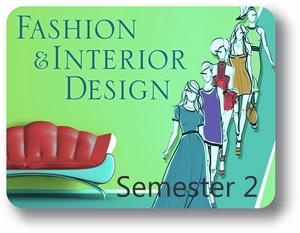Fashion and Interior Design Semester 2

Course Overview:
Get ready to try your hand at designing as you learn the basics of color and design then test your skills through hands-on projects. In addition, you’ll develop the essential communication skills that build success in any business. By the end of the course, you’ll be well on your way to developing the portfolio you need to get your stylishly clad foot in the door of this exciting field.
Required Materials:
- Clothing items
- Sewing machine
- Digital camera or camera phone
- Thread
- Fabric
- Clothing patterns
- Measuring tape
- Sketchpad
- Paper
- Scissors
Syllabus:
Unit 6: Fashion Design Project
This unit is a little more hands-on than the previous ones. You have already learned a lot about the fashion industry, from the careers available to how to thread a sewing machine. Now it is time to pull it all together. As you know, there is a lot more to fashion than just looking good. In this unit, you will create an outfit and demonstrate your understanding of the fashion industry by considering all aspects, including cost, market, and production. Making at least one piece of the outfit yourself will help you further develop your sewing or accessory design skills. You will also explain the rationale behind your choices and demonstrate your understanding of the industry as you pitch your outfit as an example of your line to a potential buyer, developing leadership and presentation skills. You will keep a journal of the entire process to show what you have learned. This unit will also provide you with some pieces that could be the beginning of your portfolio if you are seeking an internship or entry-level position.
What will you learn in this unit?
- Select materials and supplies for fashion projects.
- Calculate the costs of a given fashion project.
- Interpret written directions for constructing a fashion project.
- Apply math skills and construct a fashion project.
- Identify steps of the decisions-making process.
- Describe the difference between a need and a want.
- Explain how values and goals affect decisions.
- Identify and utilize the planning process.
- Develop a personal-growth project.
Unit 7: Interior and Environmental Design
Students will be introduced to the many ways in which environmental design factors into many aspects of the design field. By weighing the advantages and challenges of incorporating environmentally friendly products, students will better understand the merits of these designs. They will create their own repurposing project and find an innovative use for household objects. This unit also considers cultural factors that influence design and how to recognize some distinct features of an era.
What will you learn in this unit?
- Explain the impact of political and social climates on decorating styles.
- Define green design.
- Research eco-friendly design products.
- Examine the positive and negative impact that a design product has on the environment.
- Redesign an item into another useful product.
Unit 8: Considering Interior Design
You will learn the basic categories of furniture and styles within those categories, as well as how to choose furniture for a room by considering scale, function, and placement. You will further develop hands-on skills by planning, designing, and completing an interior design project while using basic skills to calculate materials and staying within a budget.
What will you learn in this unit?
- Identify the characteristics of furnishing styles.
- Identify factors that impact furnishing choices.
- Apply the principles and elements of the design in selecting an interior design project.
- Interpret written directions for assembling/constructing an interior project.
- Apply math skills and construct interior design projects.
Unit 9: Interior Design Project
In this unit, you will learn some hands-on applications for the design skills that you have been building throughout the course. You will complete a larger project and design a complete room while sticking to a budget. Because interior designers work with clients, you will also learn to work with others as you demonstrate your leadership skills while collaborating with a group. Finally, it is time to share your designs so that you can build some presentation skills in your own fashion and design show.
What will you learn in this unit?
- Apply the principles and elements of design in selecting an interior design project.
- Work cooperatively as a group member to achieve organizational goals.
- Demonstrate leadership roles and organizational responsibilities.
- Exhibit work expectations of an employer in the design industry.
- Apply math, reading, science, and critical thinking skills as they relate to the design industry.
- Identify steps of the decision-making process.
- Distinguish between a need and a want.
- Explain how values and goals affect decisions.
Unit 10: Presenting as a Professional
Now that you have learned at lot about the basics of the fashion and interior design industries, it is time to examine career prospects in the field and identify the steps to getting a job, including how to communicate and present yourself professionally. While your design skills and creativity are important, employers also look for those with good work ethics, so here you will learn about expectation in the working world. This unit will require you to practice interview skills and investigate the possibility of a part-time job or internship. You will also select your best work as the foundation for your professional portfolio.
What will you learn in this unit?
- Identify and utilize the planning process.
- Develop a personal growth project.
- Identify personal talents and abilities that can contribute to self-esteem and success in the workplace.
- Practice employability skills.
- Practice a positive work ethic and identify negative work ethics.
- Exhibit work expectations of an employer in the design industry.
- Demonstrate communication skills that promote positive relationships in the workplace.
- Research and present information on a design career to include roles and responsibilities, employment opportunities, and requirements for education and training.


